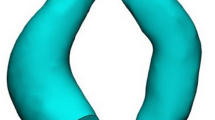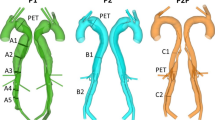Abstract
Image-based CFD can support diagnosis, treatment decision and planning. The ability of CFD to calculate pressure drop across the aortic coarctation is the focus of the 2013 STACOM Challenge. The focus of our study was inflow conditions. We compared a MRI-based inlet velocity profile with a swirl and an often used plug velocity profile without swirl. The unsteady flow simulations were performed using the solver FLUENT with consideration of the challenge specifications. For outflows, the constant outflow ratios of the supra-aortic vessels were set. The consideration of a secondary flow (swirl) at the inlet of the ascending aorta significantly affect (reduce) the calculated pressure drop across the aortic coarctation and hence the treatment decision. Furthermore, using MRI-measured flow rates at the ascending and the descending aorta without a proof of data consistency could result in an overestimated pressure drop due to overestimated flow into the supra-aortic vessels.
Access this chapter
Tax calculation will be finalised at checkout
Purchases are for personal use only
Preview
Unable to display preview. Download preview PDF.
Similar content being viewed by others
References
Warnes, C., Williams, R., Bashore, T., Child, J., Connolly, H., Dearani, J., del Nido, P., Fasules, J., Graham, T., Hijazi, Z., Hunt, S., King, M., Landzberg, M., Miner, P., Radford, M., Walsh, E., Webb, G.: ACC/AHA, Guidelines for the Management of Adults With Congenital Heart Disease. Circulation 118, E714–E833 (2008)
Goubergrits, L., Mevert, R., Yevtushenko, P., Schaller, J., Kertzscher, U., Meyer, S., Schubert, S., Riesenkampff, E., Kuehne, T.: The Impact of MRI-Based Inflow for the Hemodynamic Evaluation of Aortic Coarctation. Ann. Biomed. Eng. (in press)
Morbiducci, U., Ponzini, R., Gallo, D., Bignardi, C., Rizzo, G.: Inflow boundary conditions for image-based computational hemodynamics: impact of idealized versus measured velocity profiles in the human aorta. J. Biomech. 46, 102–109 (2013)
Itu, L., Sharma, P., Ralovich, K., Mihalef, V., Ionasec, R., Everett, A., Ringel, R., Kamen, A., Comaniciu, D.: Non-invasive hemodynamic assessment of aortic coarctation: validation with in vivo measurements. Ann. Biomed. Eng. 41, 669–681 (2013)
Kilner, P.J., Yang, G.Z., Mohiaddin, R.H., Firmin, D.N., Longmore, D.B.: Helical and retrograde secondary flow patterns in the aortic arch studied by three-directional magnetic resonance velocity mapping. Circulation 88, 2235–2247 (1993)
Author information
Authors and Affiliations
Editor information
Editors and Affiliations
Rights and permissions
Copyright information
© 2014 Springer-Verlag Berlin Heidelberg
About this paper
Cite this paper
Schaller, J., Goubergrits, L., Yevtushenko, P., Kertzscher, U., Riesenkampff, E., Kuehne, T. (2014). Hemodynamic in Aortic Coarctation Using MRI-Based Inflow Condition. In: Camara, O., Mansi, T., Pop, M., Rhode, K., Sermesant, M., Young, A. (eds) Statistical Atlases and Computational Models of the Heart. Imaging and Modelling Challenges. STACOM 2013. Lecture Notes in Computer Science, vol 8330. Springer, Berlin, Heidelberg. https://doi.org/10.1007/978-3-642-54268-8_8
Download citation
DOI: https://doi.org/10.1007/978-3-642-54268-8_8
Publisher Name: Springer, Berlin, Heidelberg
Print ISBN: 978-3-642-54267-1
Online ISBN: 978-3-642-54268-8
eBook Packages: Computer ScienceComputer Science (R0)




